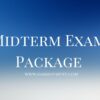Description
NR 511 Final Exam Part 1 (100/100 Points)
- Janet is a 30-year-old woman who has been recently diagnosed with a herniated disc at the level of L5-S1. She is currently in the emergency room with suspicion of cauda equina compression. Which of the following is a sign or symptom of cauda equina compression?
- The patient has acute pancreatitis with 7 of the diagnostic criteria from Ranson’s Criteria. In order to plan care, the clinician understands that this criteria score has which of the following meanings?
- Reuben, age 24, has HIV and just had a routine viral load test done. The results show a falling viral load. What does this indicate?
- Which is the differentiating symptom between labyrinthitis and vestibular neuritis?
- A 27-year-old female presents with a chief complaint of burning and pain on urination. She has no previous history of urinary tract infections. What are some additional symptoms consistent with a diagnosis of lower UTI?
- The differential diagnosis for vertigo can be classified into which of the following categories:
- Sam is a 25-year-old man who has been diagnosed with low back strain based on his history of localized low back pain and muscle spasm along with a normal neurological examination. As the clinician, you explain to Sam that low back pain is a diagnosis of exclusion. Which of the following symptoms would alert the clinician to the more serious finding of a herniated nucleus pulposus or ruptured disc?
- Preceptors must always see the patients that the students see in the clinical setting
- An 82-year-old man is seen in the primary care office with complaints of dribbling urine and difficulty starting his stream. Which of the following should be included in the list of differentials?
- Which causes the greatest percentage of mammalian bites?
- Endoscopic report reveals the presents of Barrett’s epithelium. Which of the following information should the clinician include in the explanation of the pathology report?
- Which of the following data are indicative of testicular torsion?
- Most nosocomial pneumonias are caused by:
- A family practice office for all 5 of your clinical rotations will guarantee that you will gain the required pediatric exposure
- The most common precancerous skin lesion found in Caucasians is
- Which obstructive lung disease is classified as reversible?
- Which of the following is an example of an articular structure?
- Jennifer is an 18-year-old girl who comes to the emergency room after a fall during a soccer game. Jennifer explains that she fell on her left side and kept her arm out straight to break her fall. She has been experiencing severe pain and limited range of motion in her left shoulder. The clinician has diagnosed Jennifer with a dislocated shoulder. Which of the following statements are true concerning shoulder dislocation?
- Which of the following statements is true concerning the management of the client with a herniated disc?
- After 6 months of Synthroid therapy, the clinician should expect which of the following in the repeat thyroid studies?
- The clinician suspects that a client seen in the office has hyperthyroidism. Which of the following tests should the clinician order on the initial visit?
- Cat bites are commonly associated with which of the following pathogens?
- The 56-year-old man with chronic prostatitis should be treated with trimethoprim 80mg[1]sulfamethoxazole 400 (TMP-SMX, Bactrim) for how long?
- The A in SNAPPS stands for Assessment
- A patient is diagnosed with Giardia after backpacking trip in the mountains. Which of the following would be the appropriate treatment?
- The most cost-effective screening test to determine HIV status is which of the following?
- The clinician sees a patient who is 5 feet tall and weighs 150 pounds (:BMI 29.3). How would the clinician classify this patient?
- One of the initial steps in assessing patients with musculoskeletal complaints is to determine whether the complaint is articular or non-articular in origin. Which of the following is an example of an articular structure?
- Jennifer is an 18-year-old girl who comes to the emergency room after a fall during a soccer game. Jennifer explains that she fell on her left side and kept her arm out straight to break her fall. She has been experiencing severe pain and limited range of motion in her left shoulder. The clinician has diagnosed Jennifer with a dislocated shoulder. Which of the following statements are true concerning shoulder dislocation?
- Which of the following types of cellulitis is a streptococcal infection of the superficial layers of the skin which does not involve the subcutaneous layers?
- A 76-year-old man is seen in the office for complaints of urinary incontinence. The clinician should suspect which of these causes of incontinence in men?
- Sally, aged 25, presents with impetigo that has been diagnosed as infected with staphylococcus. The clinical presentation is pruritic tender, red vesicles surrounded by erythema with a rash that is ulcerating. She has not been adequately treated recently. Which type of impetigo is this?
- A 42-year-old woman is seen in the clinic with fever, chills, vomiting and severe dysuria. She is diagnosed with acute pyelonephritis. How should this patient be managed?
- Which of the following are risk factors associated with obesity?
- Which of the following information is essential before prescribing Bactrim DS to a 24-year-old woman with urinary tract infection?
- A 22-year-old male is seen in the clinic because he found a hard lump in his testicle during a testicular self-exam (TSE). Which of the following should be included in the differential diagnosis?
- Which of the following dietary information should be given to a patient with gastroesophageal reflux disease (GERD)?
- Which of the following are predisposing factors for pyelonephritis?
- A patient is seen in the clinic with right upper quadrant pain (RUQ) that is radiating to the middle of the back. The clinical suspects acute cholelithasis. The clinician should expect with of the following laboratory findings?
- A 25-year-old patient presents to the clinic with fatigue, cold intolerance, weight gain and constipation for the past 3 months. On physical exam, the clinician notices a sinus bradycardia, muscular stiffness, coarse dry hair and a delay in relaxation in deep tendon reflexes (DTR’s). Which of the following tests should be ordered next?
- You are preforming muscle strength testing on a patient presenting with musculoskeletal pain and find that the patient has complete range of motion with gravity eliminated. Which numeric grade of muscle strength would you give this patient?
- The patient is diagnosed with overactive bladder (OAB). Which of the following instructions should be given to this woman?
- A 28 year old patient is seen in the office with colicky abdominal pain, particularly with meals. She has frequent constipation, flatulence and abdominal distention. Which of the data makes a diagnosis of diverticulitis unlikely?
- Treatment for epididymitis includes which of the following?
- Josh, aged 22, has tinea versicolor. Which description is the most likely for this condition?
- The clinician has instructed Sam, a 25-year-old patient with low back strain, to use NSAID’s to manage his symptoms of pain and discomfort. Which of the following statements would be most appropriate with teaching Sam about the use of NSAID’ to manage his pain
- Which of the following patients are at risk for developing urinary tract cancer?
- SNAPPS pneumonic used to describe a technique in orally presenting a patient.
- The clinician is caring for Diane, a 22 year old woman who presents with an injured ankle. Diane asks if she will need an x-ray. The clinician explains to Diane that an x-ray is not always necessary for an injured ankle and that the decision to obtain radiography is dependent on the exam and Diane’s description of the injury. Which of the following clues in Diane exam or history would alert the clinician to the need for obtaining radiographs?
- A patient is seen with a sudden onset of flank pain accompanied by nausea, vomiting and diaphoresis. In addition to nephrolithiasis, which of the following should be added to the list of differential diagnoses?




